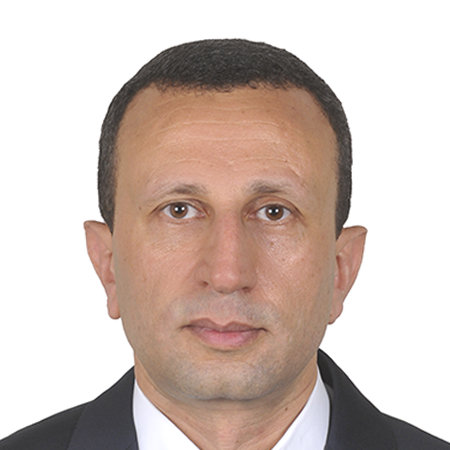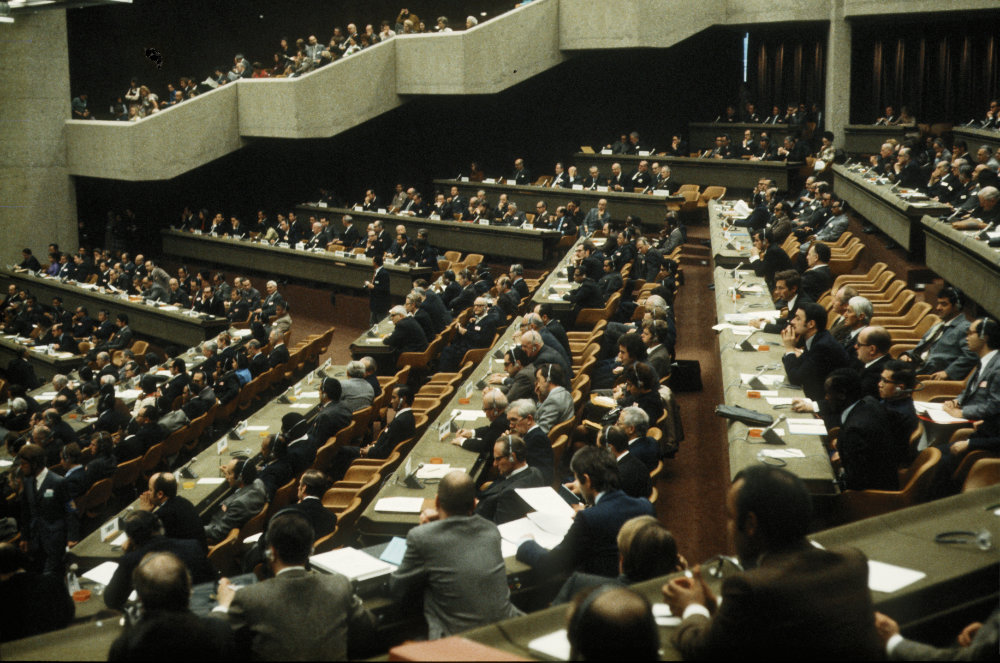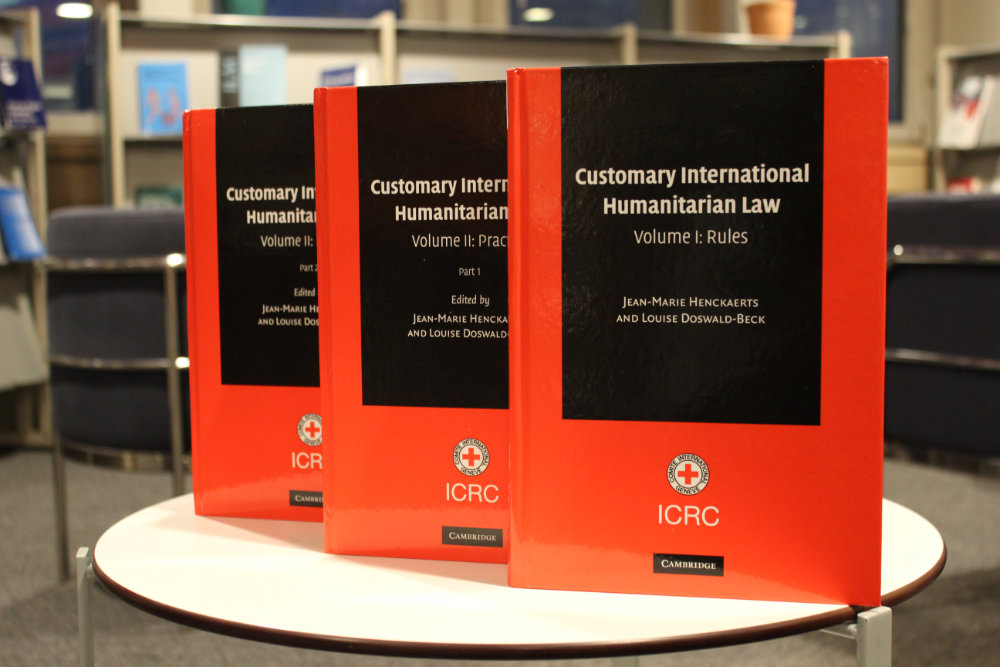References to Islamic law made by the delegations of Egypt, Saudi Arabia, Sudan and Syria during the 1974–1977 Diplomatic Conference – which led to the adoption of the two Additional Protocols to the 1949 Geneva Conventions – offer a partial glimpse into the contributions of Islamic law to the development of some modern international humanitarian law (IHL) principles.
In this post, ICRC’s legal adviser for Islamic law and jurisprudence, Ahmed Al-Dawoody and ICRC Associate Medha Damojipurapu examine some of the contributions of Islamic law to the development of the Additional Protocols, as well as the motivations for ratification by Muslim-majority states. They maintain that studying these perspectives can support humanitarian organizations to effectively communicate and anchor the protection owed to people affected by armed conflict during their dialogue in relevant contexts.
On 11 March 1974, at the Diplomatic Conference on the Reaffirmation and Development of International Humanitarian Law Applicable in Armed Conflicts, Syrian representative Mr. Abdul-Latif Abdine asserted that his country “had an age-old tradition of humanitarian law and practice.” He went on to remark that “a comparison between the humanitarian law proposed at the Conference and the justice and practice of Islam would show that little progress had been made in 1,300 years.”
Three years later at the same Diplomatic Conference, addressing the legal and ethical foundations of the Egyptian delegation’s contribution, Mr. Hamed Sultan echoed this sentiment: “Our own contribution was inspired by our age-old civilization, by our system of Islamic law and by the traditions of Arab chivalry.”
These statements reflect the deep roots of modern international humanitarian law (IHL) principles in Islamic law. However, despite the universal ratification of the Geneva Conventions of 1949 and the strong humanitarian foundations within Islamic law, contemporary armed conflicts continue to pose significant challenges to compliance with IHL – including in Muslim countries, where protection and assistance needs arising from armed conflicts account for roughly two thirds of the ICRC’s operations.
Strengthening IHL compliance: the role of shared legal and cultural traditions
On 24 February 2025, at the 58th session of the United Nations Human Rights Council in Geneva, ICRC President Mirjana Spoljaric warned that “the world – and future generations – cannot afford ever-escalating wars”. She has also urged states to make IHL a political priority, emphasizing that the responsibility to uphold IHL does not lie solely with states that are parties to an armed conflict, but rather, it is “a shared duty of all states, whether directly involved in hostilities or not, to preserve the integrity of the laws that protect humanity”.
To strengthen respect for IHL among all parties to conflict, we have to draw upon diverse sources of reference that influence the behaviour of weapon-bearers. This is particularly relevant for non-state armed groups (NSAGs), some of whom claim that they are not bound by IHL and instead claim allegiance only to their own frameworks. Given that most contemporary armed conflicts are non-international, and that in 2024 alone, 210 million persons lived in areas under the full or contested control of non-state armed groups, a pragmatic approach is essential – one that leverages all available sources to promote adherence to IHL.
The universal nature of IHL, both as a body of law and a set of humanitarian principles, becomes even more apparent when we recognize that its core principles are shared across different legal systems, cultures, and religions. Islam, Buddhism, Native American laws of war, and African and Chinese traditions, to name a few, wield tremendous influence over the behaviour of billions of people, including weapon-bearers.
Islamic law, as one of the oldest legal systems in the world, has developed elaborate rules regulating the conduct of war, most of which resonate with contemporary IHL principles. In its declaration and notification on adopting Additional Protocol I, dated 9 October 1992, Egypt stated that:
“On the basis of its strong conviction of the principles of the great Islamic Sharia, the Arab Republic of Egypt wishes at the same time to emphasize that it is the duties of all nations alike to refrain from the involvement of innocent civilians in armed conflict; furthermore they should make all efforts, to the maximum extent possible, to that end as this is indispensable for the survival of humanity and the cultural heritage and civilization of all countries and nations.”
The significance of these words is threefold: first, they underscore the relevance of diverse legal systems in the ratification and compliance with treaties; second, they remain a timely warning on the protection of civilians in armed conflict; and third, the call for “all nations” to uphold their responsibility to protect humanity in armed conflict echoes the ICRC’s 2024 Global Initiative to galvanize political commitment to IHL and to elevate it as a global priority.
In the following sections, we examine three key issues where Islamic law emerged in discussions at the Diplomatic Conference: the principle of distinction, the protection of places of worship, and the protection of the environment.
The principle of distinction
At the tenth and eighteenth plenary meetings of the Diplomatic Conference, Egypt and Syria both emphasized that the principle of distinction – a core tenet in international humanitarian law – is also deeply rooted in Islamic law. On 5 March 1974, for example, Egyptian representative Mr. Sultan affirmed that:
“The general principles of Islamic law applicable to armed conflicts included the following obligations: the obligation to distinguish clearly between combatants and non-combatants, the latter to be given general and complete protection; the obligation to establish a clear distinction between civilian property and military objectives…”
Syria further noted that historical military instructions given by Muslim leaders reinforced these principles, emphasizing that “a clear distinction was made between combatants and the civilian population; the killing of children, the old and the sick was prohibited.”
The Islamic legal discussion on the principle of distinction is based on the Qur’an (2:190): “And fight in the way of God those who fight against you and do not transgress, indeed God does not like transgressors.” Additionally, numerous Hadiths (reported sayings, deeds and tacit approvals of the Prophet Muhammad), along with instructions from early Muslim leaders to army commanders and soldiers and rules developed by Islamic jurists, clearly set out the protection of civilians and persons not taking part in hostilities from being targeted during military operations, provided that they do not participate in hostilities.
Despite these well-established legal protections, civilians continue to bear the brunt of today’s armed conflicts. In recent years, civilians have reportedly accounted for nearly 90 per cent of war-time casualties. The 2024 annual report of the UN Secretary-General on the Protection of Civilians in Armed Conflict shows that throughout 2023, “hundreds of thousands of civilians were killed or suffered appalling injuries as victims of deliberate or indiscriminate attacks, as well as purportedly lawful attacks under international humanitarian law”. In its 2019 Challenges Report, the ICRC called for better protection for civilians in urban warfare and, tragically, its 2024 Challenges Report found that the situation had deteriorated even further, underscoring the urgent need for renewed commitment to IHL.
Protection of places of worship
During the Diplomatic Conference, the protection of cultural property – particularly places of worship – was strongly emphasized by the delegations of Saudi Arabia and Sudan. Both called for greater recognition of the need to safeguard religious sites during armed conflict.
Mr. Abdul Majid Nematallah, representing Saudi Arabia, highlighted the alignment between Islamic principles and the protection of places of worship, stating:
“The delegations of the Islamic countries and the delegation of the Holy See had recognized the importance of bringing places of worship under the protection afforded by Article 47 bis. Throughout history, Moslems had traditionally respected the places of worship of other faiths. Islam was based on principles of tolerance and religious freedom, and the Islamic countries therefore desired to give all places of worship the protection to which they were entitled.”
Similarly, in explaining its vote on Article 47 bis, which addresses the protection of cultural objects, the Sudanese delegation expressed its strong support for extending these protections to places of worship, stating it was:
“very glad that this Conference has adopted by consensus Article 47 bis after approving an amendment to the effect that places of worship should be added to historical sites and works of art to constitute the cultural or spiritual heritage of peoples… [the delegation adds that] places of worship, whether mosques for Moslems, churches for Christians of all sects, or synagogues for Jews, are all sacred to us and their respect an imperative for all; for each one’s holy rites are observed in complete freedom within these holy places.”
These statements underscore the protection of religious freedom and places of worship under Islamic law – “monasteries, churches, synagogues and mosques” – as emphasized in the Qur’an (22:40).
Nearly half a century later, the destruction of religious sites and places of worship in armed conflicts remains alarmingly widespread across different parts of the world. When launching the UN Plan of Action to Safeguard Religious Sites in 2019, UN Secretary-General António Guterres emphasized that places of worship “must be safe havens for reflection and peace, not sites of bloodshed and terror.”
Protection of the environment
On 3 June 1977, the Saudi Arabian delegation affirmed that “in Islamic society, war is always defensive, merciful and humanitarian. Its sole aim is to repel aggressors without exposing either civilians, cultural objects or the environment to danger.” Similarly, on 5 March 1974, Mr. Sultan (Egypt) emphasized that “the general principles of Islamic law applicable to armed conflicts included … special protection to goods essential to the survival of the civil population and installations containing dangerous forces.”
The obligation to protect the environment during war is reinforced in the ICRC’s 2020 Guidelines on the Protection of the Natural Environment in Armed Conflict. In the Islamic law of war, the protection of the environment surfaces as a major concern, alongside the protection of civilians. Any damage to the natural environment – whether in peacetime or beyond what is lawfully permitted during armed conflict – is classified as fasād fī al-arḍ (literally, ‘destruction/mischief in the land’), a serious offense described in the Qur’an (e.g., 2:205; 5:32-33). Under Islamic law, this concept is one of the acts falling within the crime of terrorism, highlighting the severity of environmental destruction in the context of war.
While a certain amount of environmental damage may be inherent in armed conflict, its effects on livelihoods, food security, health and survival of dependent communities may persist for decades after the fighting ends. On 6 November 2020, marking the annual International Day for Preventing the Exploitation of the Environment in War and Armed Conflict, the UN Secretary-General Guterres highlighted the deep links between conflict and environmental harm, stating:
“at least 40 per cent of all intrastate conflicts have had an important natural resource dimension […] And, all too often, the environment is among the casualties of war, through deliberate acts of destruction or collateral damage, or because, during conflicts, governments fail to control and manage natural resources”.
Today, advancements in digital technology provide a better understanding and analysis of environmental damage in armed conflict, offering new tools to prevent or mitigate its impact. In 2023, over 120 states, including many with Islamic legal traditions, convened to share national experiences, challenges and good practices in protecting the environment in armed conflict. The ICRC’s 2024 Report on IHL and the Challenges to Contemporary Armed Conflicts outlines key recommendations for strengthening environmental protection in conflict settings, emphasizing the urgent need for greater compliance and preventive measures to reduce long-term harm.
Conclusion
Today, IHL treaty and customary rules represent a global commitment to protecting our humanity and the natural environment in armed conflict. Respect for IHL is essential to ensuring effective and impactful protection to both.
It is important to remind parties to armed conflicts of their legal obligations to respect IHL. First, because IHL is the product of global ownership, reflecting humanity’s age-old efforts to impose limits on warfare and bring a measure of humanity to conflict. Ensuring its faithful implementation and interpretation is a collective responsibility – one that is central to preserving our shared humanity in war. This objective is a common aspiration of both IHL and Islamic law.
Second, as ICRC Vice President Gilles Carbonnier has pointed out, “complying with IHL limits the human and socioeconomic costs of war, and helps pave the way toward peace.” Conversely, violations of IHL not only exacerbate suffering, but can destabilize entire regions and threaten global security.
To be truly effective, IHL must be recognized for what it is – a universal framework, crafted by all, for all – to be respected in all contexts.
Authors’ note: The idea for this post came as result of research for a potential submission of a chapter to a book project titled “Faith in Human Rights Treaties: Legal and Religious Commentaries for Research and Peer-Learning”.
See also:
- Ahmed Al-Dawoody, International humanitarian law and Islamic law: a principled and inclusive dialogue, July 25, 2024
- Ioanna Voudouri, Ezat Gul, & Yari Yar Mohammad, How do IHL and Islamic law protect and ensure humanitarian assistance in Afghanistan?, April 28, 2022
- Ahmed Al-Dawoody & Tilman Rodenhäuser, The principle of non-refoulement under Islamic law and international law, June 20, 2021
- Ahmed Al-Dawoody, GCIII Commentary: an Islamic perspective on the treatment of prisoners of war, January 26, 2021
- Ahmed Al-Dawoody, Respect for the dead under Islamic law: Considerations for humanitarian forensics, November 1, 2018






